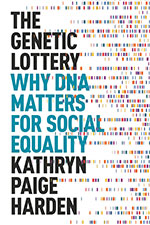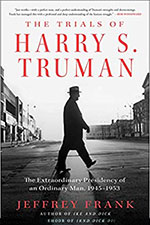 VERDICT: Touchdown!
VERDICT: Touchdown!
The Genetic Lottery: Why DNA Matters for Social Equality
By Kathryn Paige Harden (Princeton, NJ: Princeton Univ. Press, 2021). 288 pgs. $26.95. Order, www.amazon.com.
Reviewed by Dianne Post
Eugenics has gotten a bad rap in the United States and abroad because it has been used for nefarious purposes. Many people know about the Buck v. Bell case, Jim Crow laws, and the “Bell curve” here and the Nazi eugenics program in Germany before and during World War II. Recently a scandal arose about DNA being taken without consent from Uyghur people in China, and on NPR a Native American scientist explained that having some Native DNA does not make a person a tribal member.
Harden wants to turn around the negatives. This dense book focuses on fairness as the main issue and how knowledge of DNA should be used to increase fairness, not reduce it. After all, we don’t choose our genes any more than we choose our parents, so the outcome of those genes is not our “fault.” Nor should genetic inheritance be used to punish certain people, for example, with differential health care, harsh criminal regimes, or failing education systems.
The Declaration of Independence states that “all men are created equal,” but people knew when it was written that this statement wasn’t true and we certainly know that today. But being different or having different traits and skills is not a measure of superiority or inferiority – it’s merely a difference. Variety is necessary to have a good society. If everyone were a lawyer, who would do heart surgery or fix cars?
Societies have created inequality based on traits that are not choices, for example, sex, sexual orientation, height, and color of skin. I don’t say “race” because scientifically there is no such thing. Societies define what is valued and what is not, what is rewarded and what is not. Societies have created hierarchies based on educational attainment, which can be constrained by DNA but is also constrained by society to protect a superior position.
You don’t have to be a scientist or mathematician to comprehend this book. It’s written in understandable language. Many studies and references can take you into the weeds if that’s where you want to go. The author points out defects in some studies and research questions that remain. The data and interpretations have thus far been both overinclusive and underinclusive. The author constructs her argument within each chapter and also in three sections within the book. We can all relate to understanding a complex argument. Doing so will make you think, make you question, and, I hope, make you act. WL
Dianne Post, U.W. 1979, is an international human rights lawyer. She practiced family law in Arizona for 18 years, mostly representing battered women and molested children, and then in 1998 began doing international work mainly on gender-based violence.
 VERDICT: It’s a Keeper
VERDICT: It’s a Keeper
The Trials of Harry S. Truman: The Extraordinary Presidency of an Ordinary Man, 1945-1953
By Jeffrey Frank (New York, NY: Simon & Schuster, 2022). 494 pgs. $28. Order, www.amazon.com.
Reviewed by Timothy B. Daley
Jeffrey Frank likens Harry S. Truman to a “character from a Mark Twain fable: A Missouri Farmer in FDR’s Court.” Frank covers all of Truman’s many accomplishments but not all of them are given equal treatment in this volume. The book opens with a prologue to give the reader a brief glimpse into Truman’s life before he became president in 1945. The next 27 chapters are devoted to his presidency, followed by an epilogue titled “Citizen Truman.”
Germany was defeated. FDR was dead. Truman was President. The war against Japan continued.
Among the first things for Pres. Truman was a conference at Potsdam, Germany, with Churchill and Stalin in July 1945. Churchill hit it off with Truman, but their relationship was short-lived because Churchill’s party was voted out of office on July 25. Churchill departed for England. Stalin was Stalin. His biggest concerns were the boundaries of Germany and Poland after the war. Truman’s departure from Potsdam was carefully timed. While on the USS Augusta heading back to the United States, he was informed that the first atomic bomb had been dropped on Hiroshima. He arrived in the United States on August 7. On August 9, a second atomic bomb was dropped, this one on Nagasaki. If the Japanese had not unconditionally surrendered, then Tokyo was the next target. The atomic era had begun.
Soviet ambitions are the theme for many of the ensuing chapters. Milwaukee native George F. Kennan, who was the U.S. ambassador to the Soviet Union, was asked for his analysis of Soviet aims. Kennan’s 8,000-word cable became known as the “Long Telegram.” “Containing” the Soviets became the heart and soul of Truman’s foreign policy. Some thought that “a war with Russia … was inevitable and the quicker it came the better.” The Iron Curtain had fallen.
Want to Review a Book?
Please request a book and writing guidelines from Wisconsin Lawyer managing editor Karlé Lester, at klester@wisbar.org or (608) 250-6127. Reviewers may keep the book reviewed. Reviews of about 500 words are due within 45 days of receiving the book. Reviews are published, space permitting, in the order received and may be edited for length and clarity.
Not completely satisfied with the Long Telegram, Truman asked new special counsel Clark Clifford for another report. Clifford delivered “American Relations with the Soviet Union” on Sept. 24, 1946. Its tone was so stern and critical of Soviet intentions that Truman buried it, demanding that all copies be turned over to him lest they be leaked and cause a diplomatic nightmare. The Cold War was on.
On Feb. 21, 1947, Great Britain announced its intent to withdraw its military support from Greece and Turkey. The Turkish Straits are a vital passageway linking the Black Sea to Europe. The Russians wanted more control of the Straits and still do today. The United States stepped in, and the beginnings of the Truman Doctrine took shape: The United States would assist free peoples in their defense from outside pressures, namely communism.
On June 5, 1947, while accepting an honorary degree at Harvard, George C. Marshall, then U.S. Secretary of State, gave a speech that became the impetus for more aid to war-stricken Europe. The European Recovery Program, better known as the Marshall Plan, was $17 billion to 16 countries over four years. Not mentioned in this book is the fact that Marshall won the Nobel Peace Prize in 1953. Unfortunately for readers, the details and results of the Marshall Plan are also not discussed in this book.
A president can only be as good as the people around him. Truman was surrounded by Dean Acheson, W. Averell Harriman, George F. Kennan, Clark Clifford, Dwight Eisenhower, and the aforementioned Marshall. These men were instrumental in bringing about the extraordinary presidency of Harry S. Truman.
The next part of the book gives a limited discussion to many topics and events, including the recognition of Israel, the Berlin airlift, the 1948 election, desegregation of the federal workforce and armed forces, the early days of the United Nations, Sen. Joe McCarthy (R-Wis.), and creation of the Department of Defense, the Atomic Energy Commission, the National Security Council, the Central Intelligence Agency, and NATO (to which Eisenhower was appointed as the first commander).
Beginning with “A Border Incident,” chapter 19, the book devotes five chapters to Korea and Gen. Douglas MacArthur. I found this to be the strongest and most interesting part of this biography. Truman and Gen. MacArthur met on Wake Island on Oct. 15, 1950. After his successful Inchon landing, MacArthur predicted that some troops would be home by Thanksgiving. MacArthur’s insubordination is detailed, as is his fateful advance across the 38th Parallel, which prompted 300,000 Chinese combatants to enter the war. MacArthur reported on Nov. 28, 1950, that based on the entry of the Chinese forces, “We face an entirely new war.” MacArthur’s earlier prediction of victory in Korea came crashing down. The following April, Truman relieved him of his command.
The next chapter discusses the 1952 steel workers strike during which Truman attempted to seize the steel industry, which he considered vital to national security. The steel companies sued and won at the U.S. Supreme Court. After this is a chapter about the 1952 presidential election, in which Dwight Eisenhower defeated Adlai Stevenson, and then a chapter about the peaceful transfer of power in 1953.
During breaks from reading this biography, I went to cable news to get updates on the invasion of Ukraine. The more I read, the more commonalities that emerged. Has anything changed since the end of World War II or the Korean War? The names Stalin and Putin are interchangeable. What Stalin said about neighboring nations then is what Putin is saying today. The best part of reading this book is the introspection that it will deliver to the reader, in comparing the Truman years to the world now. History keeps repeating itself. This is a timely piece of history as events unfold in eastern Europe. If you are looking for only a basic biography of Truman’s presidency, then this book should be suitable. If you crave more, I recommend David McCullough’s definitive 1992 biography, Truman.
Timothy B. Daley, Marquette 1977, now retired from private practice, lives in Racine County.
